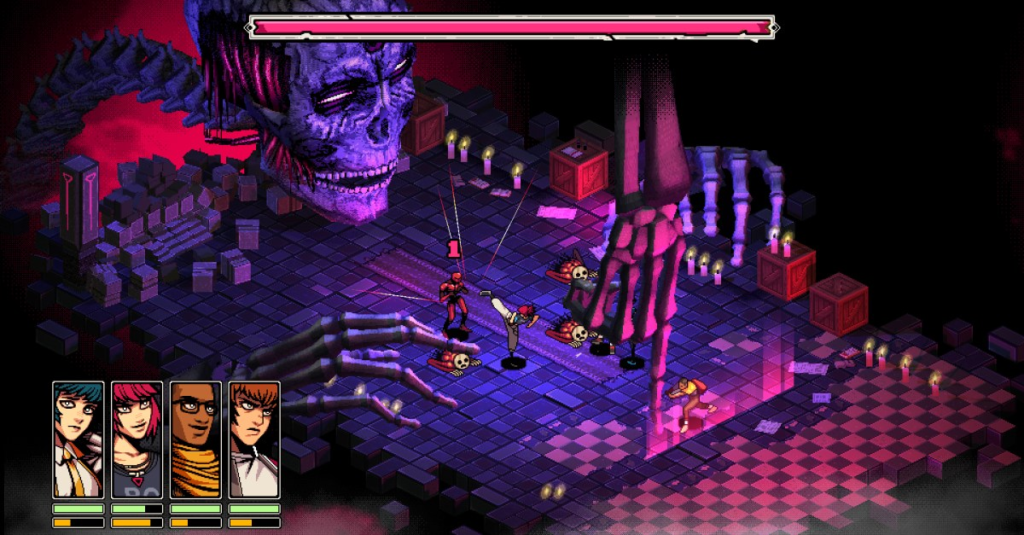
In one particularly memorable sequence in Demonschool — the new tactical RPG from Necrosoft that, after a few hiccups, releases on November 19th — I throw a doll at a zombie’s head, dispatch it with a roundhouse kick to the jowls as I watch my friends sweep demons off the floor in vortices of blood, and celebrate by returning to town and petting a dog. All in the name of passing a college assignment that I’m juggling alongside deciphering a millennia-old apocalyptic prophecy and making new friends.
For Demonschool’s demon-hunting protagonist, Faye, that would all preferably be achieved by kicking the apocalypse, and coursework, into submission across 10 in-game weeks of reference-laden gore.
Necrosoft isn’t shy about those inspirations, either. Launching from a setup that screams Buffy the Vampire Slayer, a color palette ripped from Dario Argento’s Suspiria, and a smörgåsbord of horror — your first in-game quest is to track down a videotape that kills you within three days of viewing — Demonschool injects its own philosophy into what it draws from what’s come before. If “take your time” in Persona 5, another of Demonschool’s many influences, felt more like a threat in a 100-plus-hour game, Demonschool’s deployment of the phrase is more sincere. There’s no time pressure to its main quest and, but for a few rhythmic missteps, the time you spend in Demonschool is yours to do with as you will.
That time will be split between two things. The first: exploring an island and engaging with its increasingly eerie residents — including a child whose ambition is to grow up to be a bench — and the comic interludes you and your growing band of new pals consistently wind up in. Upon arriving on the island, for instance, Faye drags reluctant new best friend Namako to explore, only to end up in a fight with local thugs (a hobby of Faye’s we’ll revisit shortly). “We’re hitting the town,” she tells Namako. “Pretend those guys are the town!”
The rest will be spent in Demonschool’s rendition of grid- and turn-based combat, with a focus on positional gameplay, where you’ll be maneuvering characters behind enemies. Faye’s basic attack pushes enemies back a square — enemy attacks can similarly influence your position — while Namako can phase through demons and drag them toward her original position. Drive enemies between characters and you can unleash a powerful combo; do enough damage and you can access characters’ special moves. Tactical combat becomes a string of considerations of how to maneuver enemies into your line of attack and stay out of range of their (often devastating given characters’ limited health) rebuttals.
That’s just the “planning phase.” The “action phase” follows, in which everything you’ve made your characters do is played out and, in the right combinations, sees your team weave around one another in cinematic — and cool-as-hell — ballets of punching, kicking, and arcane magic.
It lends a directorial bent to already tactically deep gameplay, as you decide not just what will finish a fight but how to look good while doing it. Which is fortunate, because you will be getting into a lot of fights. Getting to know your friends? Time for a fight. Completing an incremental step of a weekly assignment? Fight. Taking a break with a side quest? Fight. Going to the restroom? Fight… with 50 ghosts.
This isn’t unusual for an RPG, though these are unavoidable scripted events rather than random encounters, nor are these battles especially hard. But not being able to move to a new screen without running into a fight can get old fast. It only took me until the second week to toggle on the “almost invincible” accessibility option — Demonschool lets you rewind your movements and restart battles without penalty to clean up mistakes, too — just for a cognitive break while encountering fights every few minutes.
There’s a hint of self-awareness about the frequency of fights, which are occasionally refreshed as you develop new skills and find new companions, as Namako early on bemoans not being able to walk into Temsk’s cemetery without being ambushed by gangsters and the undead (yeah, Namako, I know how you feel).
The weight of that specific frustration is lessened, however, by everything else Demonschool offers. Let’s be honest: main quests are fine, but I’d rather decorate my clubhouse with friends, explore Temsk’s nightlife, and pull demon fish from the depths in a now-obligatory-in-RPGs fishing minigame.
There is a refreshing lack of extravagance to this side content, especially compared to where Necrosoft draws its inspiration from. Like all good high school horror, Demonschool is less about fighting the big bad than bringing together a found family of complex and relatable misfits to do so. In its straightforward approach to this aspect of Demonschool, Necrosoft not only lets its writing — particularly of its characters, who genuinely develop and grow — shine through, but also relieves potential for frustration. But for the odd misplaced karaoke lyric, if you spend time with your friends you become closer to them.
Demonschool has rough edges, particularly in how it balances its excellent writing with slightly-too-frequent (though still interesting) combat. But in its open approach to its influences — while avoiding feeling like a lesser copy — its wit, and its charm, it builds a unique identity from its melting pot of inspirations to leave its deficiencies far outweighed by how much there is to love.
Demonschool launches on November 19th on the Switch, PC, PlayStation, and Xbox.

